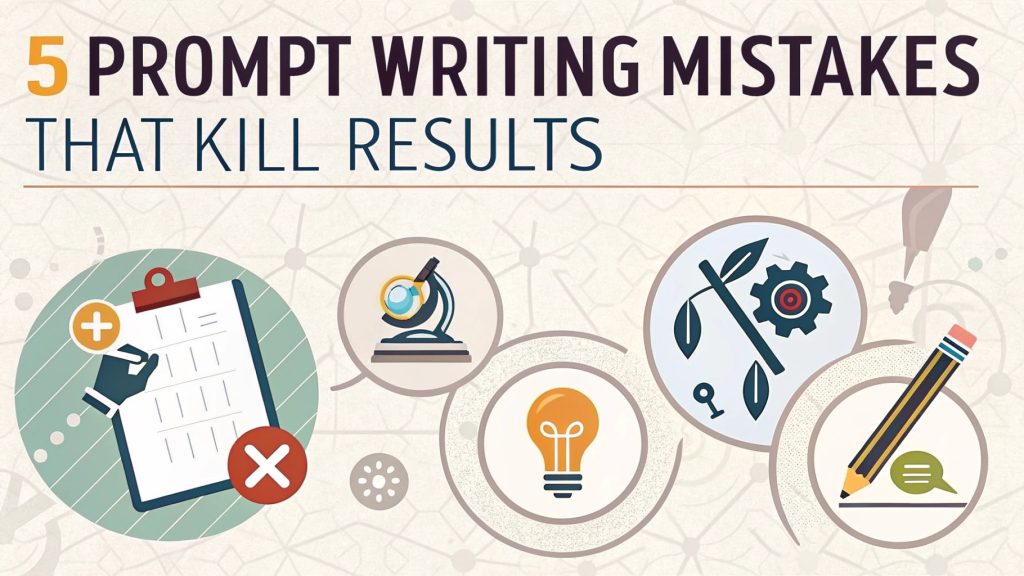Avoid these 5 prompt writing mistakes to get better, faster AI results. Clear fixes included
Struggling to get great results from AI tools? It might not be the platform — it might be the prompt. Many users make the same 5 mistakes that quietly sabotage their output. In this guide, you’ll learn what those mistakes are and how to fix them for sharper, smarter results.
1. Being Too Vague with Your Input
Why It Fails
Generic prompts like “Write a blog post about marketing” don’t give AI enough direction. You’ll get surface-level, uninspired content that feels robotic or bland. The AI isn’t mind-reading — it’s pattern-following. If your input is fuzzy, the output will be too.
How to Fix It
Be specific about the topic, tone, format, and target audience. For example:
Write a 500-word blog post in a friendly tone for beginner entrepreneurs on how to use Instagram for business growth.
That one tweak adds clarity — and gets you much closer to usable results.
2. Skipping Context or Audience Clarity
Why It Fails
If you don’t tell the AI who it’s writing for, it will guess — and usually miss the mark. That means wrong tone, irrelevant examples, or content that doesn’t match the user’s intent.
How to Fix It
Always include audience context in your prompt:
Act as a health coach. Write a 3-tip Instagram caption about stress relief for busy moms.
This helps the AI narrow in on the right language, examples, and emotional tone.
3. Ignoring Tool-Specific Strengths
Why It Fails
Each AI tool has its own sweet spot. ChatGPT is great for writing and dialogue, Jasper excels at conversion copy, and Midjourney shines with visuals. If you use the wrong tool for the task, you won’t get the results you expect.
How to Fix It
Match the prompt to the tool’s core skill:
- Use ChatGPT for blogs, summaries, and tone-specific drafts
- Use Jasper for ads, product pages, and funnels
- Use Midjourney for branded visuals and creative imagery
When you align your prompt with the tool’s purpose, the output improves dramatically.
4. Asking for Too Much in One Prompt
Why It Fails
Trying to get everything in one go — like “Write a blog post, generate 10 tweets, and write the email promo” — often leads to confusion. The AI might mix formats or miss key elements altogether.
How to Fix It
Break your workflow into steps. Start with one clear task, such as writing the blog post. Once that’s complete, generate other assets based on that content. Treat the process as a conversation — not a one-shot deal.
5. Forgetting to Iterate or Refine
Why It Fails
AI rarely nails it on the first try. Many users quit too soon or assume the first draft is final. That leads to missed potential — and frustration with “meh” output.
How to Fix It
Ask follow-ups like:
Can you make this more persuasive? Rewrite this in a humorous tone. Add bullet points to make it easier to scan.
Refining your prompt and building on responses turns OK results into great ones. Prompt writing is iterative — and your edits are part of the process.
Final Thoughts: Smarter Prompts, Better Output
The best AI results don’t come from longer prompts — they come from clearer ones. Avoiding these five common mistakes helps you unlock better content, faster workflows, and more confidence in using AI tools. Keep it simple, stay intentional, and treat every prompt like a creative brief — because it is.
AI tools are powerful — but only when your prompts are clear and strategic. By avoiding these common mistakes and applying the right fixes, you’ll start getting output that’s more relevant, engaging, and useful. Write less like a request, and more like a creative brief — and watch your results improve.

